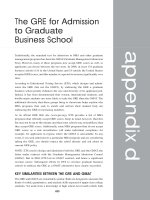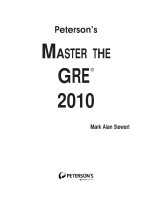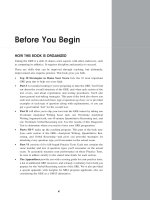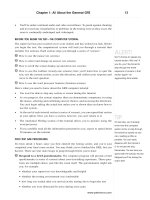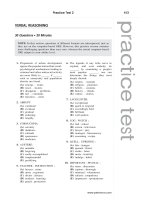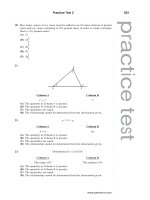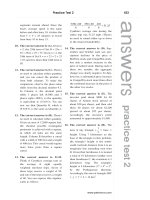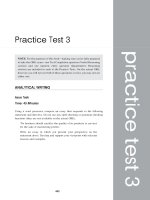Tài liệu Master the Gre 2010 - Part 3 doc
Bạn đang xem bản rút gọn của tài liệu. Xem và tải ngay bản đầy đủ của tài liệu tại đây (88.27 KB, 10 trang )
All About the
General GRE
OVERVIEW
• The GRE structure and testing format
• Your GRE scores
• Taking the GRE computer-based test
• Registering for the GRE (United States and Canada)
• GRE availability and registration (international testing)
• The paper-based GRE (for international test takers)
• Other GRE policies you should know about
• The GRE Personal Potential Index (new in 2009)
• Obtaining up-to-date GRE information
• Contacting the testing service
• General test-taking tips
• Summing it up
Your GRE preparation begins with an overview of the test and of GRE
registration and testing procedures. In this chapter, you’ll first look at the
overall structure of the GRE and find out how the exam is scored. Then you’ll
learn how the computer-based GRE testing system works and about regis-
tration and testing details for both the computer-based and the paper-based
versions of the test. The chapter concludes with a need-to-know list of GRE
test-taking tips.
Before you begin, you should become familiar with the following three
acronyms, which are used throughout this chapter and the rest of the book:
ETS (Educational Testing Service). This is the organization that designs
and administers the test. ETS also scores the GRE and reports test scores to
the graduate schools. ETS is a private nonprofit organization based in
Princeton, NJ.
GRE (Graduate Record Exam). The GRE is the primary standardized test
for admission to graduate-level academic (Masters and Ph.D.) programs in the
United States. This book uses the acronym GRE to refer only to the GRE
General Test, and not to the GRE Subject Tests (none of which are covered in
this book).
chapter1
....................................................................................
3
CBT (Computer-Based Test). This book uses the acronym CBT in reference to the
computerized version of the GRE, as well as to the computer-based testing system
itself. The CBT is the only version of the GRE available, except in certain remote
locations outside the United States, where a paper-based version is offered instead.
THE GRE STRUCTURE AND TESTING FORMAT
The computer-based GRE contains three scored sections:
One 75-minute Analytical Writing section (with two discrete timed parts)
One 45-minute Quantitative Reasoning section
One 30-minute Verbal Reasoning section
The exam also contains one additional, unscored section, either Quantitative Reasoning
or Verbal Reasoning. The unscored section allows test makers to try out new questions,
mainly to assess their difficulty level based on test takers’ responses. You may not be able
to tell which section is unscored—and in any event, you should approach every exam
section with the assumption that it counts toward your GRE score.
For some (but not all) test takers, the exam will end with an identified, untimed research
section, which is not scored and contains question types that are different than the ones
in the other sections. (The research section contains experimental question types that
are unlikely to appear on the GRE as scored questions any time soon.)
Excluding brief breaks between sections (and excluding the research section), total
testing time runs about 3 hours, 15 minutes, depending on whether your unscored
section is Quantitative Reasoning or Verbal Reasoning. In the following table, the
number of Verbal and Quantitative Reasoning questions are approximate; your exam
may contain a different number of any question type on these two sections.
TEST SECTION COMPONENTS
Analytical Writing 75 mins. (2 writing tasks):
• Present Your Perspective on an Issue (Issue task),
1 essay (45 mins.)
• Argument Analysis (Argument task),
1 essay (30 mins.)
Quantitative Reasoning 45 mins. (28 multiple-choice questions)*:
• Quantitative Comparison (14 questions)
• Problem Solving (14 questions)
Verbal Reasoning 30 mins. (30 multiple-choice questions):
• Analogies (9 questions)
• Sentence and Text Completion (6 questions)
• Reading Comprehension (8 questions,
divided among 2–4 sets)
• Antonyms (7 questions)
PART I: GRE Basics4
.................................................................
..............................................................................................
NOTE
The structure of the paper-
based GRE (offered only in
certain remote locations
outside the United States)
differs somewhat from the
computer-based GRE
structure, which is shown here.
www.petersons.com
TEST SECTION (cont’d) COMPONENTS
Unscored 30 or 45 mins.:
• Verbal Reasoning (30 questions, 30 mins.)
OR
• Quantitative Reasoning (28 questions,
45 mins.)
Research Untimed (number of questions varies)
*One of your Quantitative Reasoning questions may require you to enter (type in) your own numerical
answer instead of selecting among multiple choices.
Sequence of Exam Sections and Questions
The Analytical Writing section will be the first one on your exam. This section may start
with either the Issue writing task or the Argument writing task.
The Quantitative Reasoning and Verbal Reasoning sections (including the unscored
section) may appear in any order after Analytical Writing. For example, you might
encounter two consecutive Quantitative Reasoning sections or two consecutive Verbal
Reasoning sections. In these exam sections, question types are interspersed and
there’s no set order. (Take a quick peek at any of the Practice Tests in this book and
you’ll get the idea.)
The research section will be the last one on your exam. Remember: It won’t be scored,
and it probably won’t be timed.
Basic Ground Rules During the Exam
Here are some basic procedural rules for the GRE that will be explained in more detail
later in this chapter:
• Once the timed test begins, you cannot stop the testing clock.
• If you finish any section before the time limit expires, you may proceed immedi-
ately to the next section, at your option.
• Once you exit a section, you can’t return to it.
• The test provides an optional 10-minute break after the Analytical Writing
section and an optional one-minute break after each subsequent section. Imme-
diately after each break, the next timed section automatically commences.
• Pencils and scratch paper are provided for all exam sections.
• You compose both Analytical Writing essays using the word processor that is built
into the GRE computerized testing system. Handwritten essays are not per-
mitted. (Later in this chapter, we’ll review details about the GRE word processor.)
Here are some additional ground rules that apply specifically to the Quantitative and
Verbal Reasoning sections. We’ll go into these in more detail later in this chapter:
• The computerized test won’t let you skip questions. Also, once you confirm your
answer to a question, you can’t return to it.
Chapter 1: All About the General GRE 5
.................................................................
..............................................................................................
www.petersons.com
• An on-screen calculator is NOT provided, and calculators are prohibited in the
testing room, so during the Quantitative Reasoning section(s), you’ll need to use
your scratch paper to perform calculations.
• During the Quantitative Reasoning and Verbal Reasoning sections, you’ll be
required to select among multiple choices by clicking on the ovals next to them.
For one Quantitative Reasoning question, you might be required to type in your
own numerical answer, instead of selecting among answer choices.
YOUR GRE SCORES
You’ll receive four different scores for the GRE:
A scaled Quantitative Reasoning score on a 200–800 scale (in 10-point increments)
A scaled Verbal Reasoning score on a 200–800 scale (in 10-point increments)
A total score on a 200–800 scale (in 10-point increments), based on both your
Quantitative Reasoning and Verbal Reasoning scores
An Analytical Writing score, on a 0–6 scale, which averages the scores for each of
your two GRE writing tasks
For each of these four scores, you’ll also receive a percentile rank (0–99 percent). A
percentile rank of 60 percent, for example, indicates that you scored higher than 60
percent of all other test takers. Percentile ranks reflect your performance relative to
the entire GRE test-taking population during the most recent multi-year period.
The Scoring System for Quantitative and Verbal Reasoning
Scores for the Quantitative Reasoning and Verbal Reasoning sections are not based
strictly on the number of correct answers. Instead, each of these two scores is based on
three factors:
The number of questions you attempt
The difficulty level of the questions you answer correctly
The range of question types and topics among the questions you answer correctly
Both sections are “computer adaptive,” which means that they continually adapt to
your ability level. A computerized algorithm determines which questions are pre-
sented. For each skill area, the testing system initially presents a question that is
moderately difficult. Answering correctly moves you up the difficulty scale; answering
incorrectly moves you down to easier subsequent questions.
Generally speaking, then, the more questions you answer correctly, the greater the
difficulty level of subsequent questions and the greater credit you’ll receive for
answering them correctly as well. So even if you don’t respond to all 28 Quantitative
Reasoning or all 30 Verbal Reasoning questions, you can still attain a high score for
that section if a high percentage of your responses are correct—especially if you
respond correctly to a wide variety of question types.
PART I: GRE Basics6
.................................................................
..............................................................................................
NOTE
On the actual test, the ovals
next to multiple choices are
not lettered as they are
throughout this book.
NOTE
The computerized system’s
GRE scoring algorithms are
well-guarded secrets, but
knowing exactly how the
system works wouldn’t affect
your exam preparation or
test-taking strategy anyway.
www.petersons.com
TAKING THE GRE COMPUTER-BASED TEST
The GRE Computer Interface
The three simulated screen shots on the following pages show the GRE Computer-
Based Test interface for the Analytical Writing section, the Quantitative Reasoning
section, and the Verbal Reasoning section. Let’s first examine the features of the
interface that are common to all exam sections.
The Title Bar
A dark title bar will appear across the top of the computer screen at all times during
all test sections. (You cannot hide this bar.) The title bar displays three items:
Left corner: The time remaining for the current section (hours and minutes)
Middle: The name of the test (GRE) and current section number
Right corner: The current question number and total number of questions in the
current section (Quantitative and Verbal sections only)
00:28 GRE—Section 1: Analytical Writing
The following appeared in a memo from the manager of UpperCuts, a hair salon
located in a suburb of the city of Apton, to the salon’s owner:
“According to a nationwide demographic study, more and more people today are
moving from suburbs to downtown areas. So in order to boost sagging profits at
UpperCuts we should relocate the salon from its current location in Apton’s
suburban mall to downtown Apton, while retaining the
salon’s decidedly upscale
approach in terms of services, products and pricing. After all, HairDooz, our chief
competitor at the mall, has just relocated downtown.”
The manager’s argument relies on a series of unproven assumptions and
is therefore unconvincing as it stands. To begin with, the argument
assumes that Apton’s demographic trend reflects the national trend.
Yet, the mere fact that one hair salon has moved downtown hardly
Cut
Paste
Undo
Test
Quit
Section
Exit Time
?
Help
Answer
Confirm Next
Discuss how well reasoned you find this argument.
CBT Title Bar
Name and Number
of Test Section
Next
button
Confirm
Answer
button
Help
button
Exit
Section
button
Quit
Test
button
Time
button
Topic
suffices to |
The Toolbar
A series of six buttons appears in a toolbar across the bottom of the computer screen
at all times during all test sections. (You cannot hide the toolbar.) Here’s a description
of each button’s function:
Quit Test
Click on this button to stop the test and cancel your scores for the entire test.
(Partial score cancelation is not allowed in any event.) If you click here, a
Chapter 1: All About the General GRE 7
.................................................................
..............................................................................................
www.petersons.com
